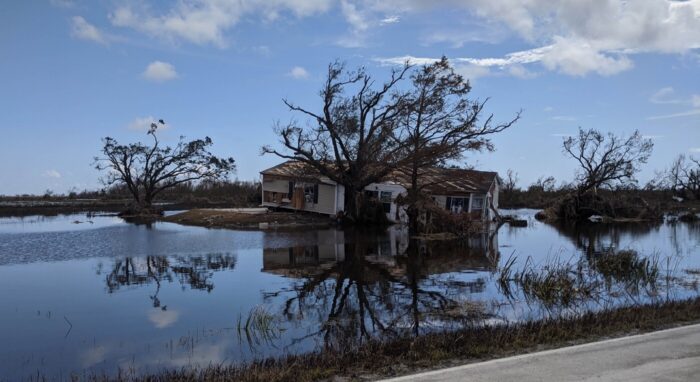Hurricane Laura damaged Paula M.’s roof so severely that the ceiling collapsed in several rooms and mold spread along ceilings and walls. Our teams mucked and gutted, remediated mold and secured a tarp over the roof, but the real battle is yet to come. This is only the beginning of Paula’s recovery journey.

The Government Accountability Office (GAO) recently released a report that evaluated the effectiveness of one of FEMA’s core programs from 2016 to 2018. They discovered what those of us working in disaster recovery have long known: FEMA’s processes are anything but clear or efficient.
If we’re going to really help Paula’s family and thousands of others, especially after Delta brought more devastation to these vulnerable communities, we will need to remedy a broken disaster recovery system. Clear solutions exist.
The GAO found that FEMA’s processes created confusion for survivors and local leaders trying to access assistance from FEMA. Survivors didn’t understand the application process, why they may have been denied or what their options were for appeals. State and local leaders were not equipped with the knowledge and data they needed to lead effective recovery efforts, and the federal government was not well prepared to provide either.
FEMA disaster recovery centers and call center staff, responsible for guiding survivors through these processes, couldn’t keep up with rapidly-changing program requirements and lacked proper training to help survivors navigate the confusion.
The report also found that FEMA began altering internal processes without stated goals for improvement. And, it failed to gather feedback from stakeholders and survivors — both critical for effective process improvement in any business.
The GAO report concludes with several recommendations that could improve the delivery of this urgently needed assistance. Many of these recommendations align with solutions that SBP has been advocating for the last few years — ideas informed by fourteen years’ of experience shrinking the time between disaster and recovery in communities across the country.
The findings of the GAO report are shocking but not surprising. America’s current approach to response and recovery is not sustainable and cannot reliably serve communities in their hour of need.
Here are two specific actions that FEMA could take to simplify application processes and award determinations:
1. Simplifying the application process is critical for FEMA to improve the survivor’s experience. In the wake of natural disasters, there are a variety of assistance programs that all require separate, detailed applications that can take weeks or months to complete as survivors try to gather all the necessary documentation.
In two of the most important applications, FEMA Individual Assistance and Small Business Administration (SBA), more than 50% of the questions are duplicates. Combining these two applications into a single one creates a simpler path for survivors and increases efficiencies between agencies collecting and verifying the same information. This would allow FEMA to more easily and predictably inform applicants of all the assistance they may be eligible for. This information can later be shared with state and local government agencies implementing long term recovery programs with other state and federal resources.
2. FEMA should also modernize its damage assessment methods to more quickly assess home damage and calculate assistance amounts. Traditionally, FEMA deploys inspectors to visually assess survivors’ homes. Because of COVID-19, FEMA moved to a model that asks survivors to self-report damages via a phone call with FEMA personnel. As a result, Hurricane Laura survivors in southwest Louisiana are already experiencing challenges.
Our initial analysis in Louisiana shows lower average FEMA award amounts when compared with Florida’s Hurricane Michael, a storm with similar wind-driven damages and impact. Hurricane Laura had 27,000 more FEMA-approved applications, but almost $2000 less in average housing assistance awards. Tens of thousands of these same families are now dealing with the impact of Delta, in real-time. Realistically, what can survivors count on? It is honestly hard to say.
This is a clear opportunity where aerial imaging and construction estimate technology from the private sector could vastly improve outcomes for survivors. The insurance industry commonly uses aerial imagery, predictive analytics, and estimation technology that allow claims to be adjusted and paid more quickly. If fully utilized by FEMA, this method of assessment can drive a more detailed understanding of the damage to homes and communities in hours and days instead of weeks or months. What’s more, it can drive philanthropic support from individuals and organizations for long-term recovery efforts.
The changes SBP proposes are bold but achievable and there are ample opportunities to test these ideas today in hurricane, tornado, and wildfire impacted communities.
We hope FEMA will use the GAO report as a tool to drive still greater continuous improvement and innovation. To honor the dignity of survivors and keep pace with more frequent and severe disasters we need big leaps forward — and the time is now.
Reese May is the chief strategy and innovation officer for SBP, a national disaster resilience and recovery organization. He leads SBP’s disaster preparedness and recovery efforts across the country, advises state and local decision-makers on effective long-term disaster recovery programs and advocates for policy change at the federal level. He is a Truman National Security Fellow.

